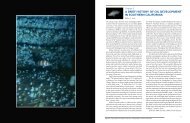checklist (pdf) - The Love Lab - University of California, Santa Barbara
checklist (pdf) - The Love Lab - University of California, Santa Barbara
checklist (pdf) - The Love Lab - University of California, Santa Barbara
Create successful ePaper yourself
Turn your PDF publications into a flip-book with our unique Google optimized e-Paper software.
Centropomus viridis Lockington, 1877. White Snook. Maximum size not clearly defined, perhaps 90–120 cm<br />
(35.4–47.2 in) TL, but perhaps to as much as 150 cm (60 in) TL (Grove and Lavenberg 1997). Southern<br />
Baja <strong>California</strong> (26°45'N, 114°15'W; SIO 98-1) to Tumbes, Peru (Chirichigno and Vélez 1998), including<br />
Gulf <strong>of</strong> <strong>California</strong> (Bussing in Fischer et al. 1995) and Islas Galápagos (Grove and Lavenberg 1997).<br />
Bays and estuaries to depth <strong>of</strong> 25 m (82 ft; Robertson and Allen 2002) and ascends streams (Allen and<br />
Robertson 1994).<br />
Family Moronidae — Temperate Basses<br />
**Morone saxatilis (Walbaum, 1792). Striped Bass. To about 122 cm (4 ft) TL in eastern Pacific; 183 cm TL<br />
(6 ft) in Atlantic. Atlantic and Pacific; Barkley Sound, British Columbia to just south <strong>of</strong> U.S.–Mexican<br />
border. Along beaches and in bays. All in Miller and Lea (1972), as Roccus saxatilis. Anadromous (Moyle<br />
2002).<br />
Family Acropomatidae — Lanternbellies or Temperate Ocean-Basses<br />
Some members <strong>of</strong> this family have a luminescent organ between the pelvic fins, for which they are called the<br />
lanternbellies. Partly because the Alaskan species does not have this organ, Mecklenburg et al. (2002)<br />
called them temperate ocean-basses from Eschmeyer and Herald (1983). <strong>The</strong> name chosen by the AFS–<br />
ASIH fish names committee (Nelson et al. 2004) is lanternbellies. <strong>The</strong> relationships <strong>of</strong> the genus Howella<br />
are unclear; sometimes placed in the family Howellidae.<br />
Howella brodiei Ogilby, 1899. Pelagic Basslet. To 10 cm (4 in) TL (Fitch and Lavenberg 1968). Pacific and<br />
Atlantic oceans; north <strong>of</strong> San Francisco, northern <strong>California</strong> (Fitch and Lavenberg 1968) to Chile<br />
(Eschmeyer and Herald 1983). Mesopelagic, 30–1,829 m or more (100–6,000 ft; Fitch and Lavenberg<br />
1968). <strong>The</strong> Atlantic form is regarded as a subspecies Howella brodiei atlantica (Post and Quéro 1991).<br />
Howella sherborni (Norman, 1930). Shortspine Basslet. To 9.2 cm (3.6 in) SL (Post and Quéro 1991).<br />
Circumglobal (Hatooka in Nakabo 2002); North Pacific Ocean south <strong>of</strong> Krenitzin Islands, Aleutian<br />
Islands (Busby and Orr 1999) to at least northern <strong>California</strong> (Savinykh 1999). Pelagic, surface to about<br />
2,700 m (8,858 ft; Mecklenburg et al. 2002).<br />
Family Polyprionidae — Wreckfishes<br />
Stereolepis gigas Ayres, 1859. Giant Sea Bass. To 226 cm (7.4 ft) TL (Eschmeyer and Herald 1983). Northern<br />
Japan and Sea <strong>of</strong> Japan (Mochizuki in Masuda et al. 1984); Humboldt Bay, northern <strong>California</strong> (Miller<br />
and Lea 1972) to Oaxaca, southern Mexico (Shane et al. in Moser 1996), including Gulf <strong>of</strong> <strong>California</strong><br />
(Miller and Lea 1972). At depths <strong>of</strong> 5–46 m (18–150 ft) (min.: Miller and Lea 1972; max.: Eschmeyer<br />
and Herald 1983).<br />
Family Serranidae — Sea Basses and Groupers<br />
Alphestes immaculatus Breder, 1936. Pacific Hamlet or Pacific Mutton Hamlet. To 30 cm (11.8 in) TL (Allen<br />
and Robertson 1994). Islas San Benito, central Baja <strong>California</strong> (L. McDonald, pers. comm. to M. L.),<br />
mainland as far north as Laguna de San Ignacio, southern Baja <strong>California</strong> (De La Cruz-Agüero and<br />
Cota-Gómez 1998) and Gulf <strong>of</strong> <strong>California</strong> (Allen and Robertson 1994) to Pucusana, Peru (Chirichigno<br />
and Vélez 1998) and Islas Galápagos (Grove and Lavenberg 1997). At depths <strong>of</strong> 3–30 m (10–98 ft) (min.:<br />
Pérez-España et al. 1996; max.: Robertson and Allen 2002). Also recently as Alphestes galapagensis.<br />
Alphestes multiguttatus (Günther, 1867). Many-spotted Hamlet, Pacific Guaseta, or Rivulated Mutton<br />
Hamlet. To 25 cm (9.8 in) TL (Allen and Robertson 1994). Bahia Magdalena, southern Baja <strong>California</strong><br />
(SIO 64-54) to Caleta La Cruz, Peru (Chirichigno and Vélez 1998), including Gulf <strong>of</strong> <strong>California</strong> (Allen<br />
and Robertson 1994). Intertidal and to 30 m (98 ft; Allen and Robertson 1994).<br />
109




